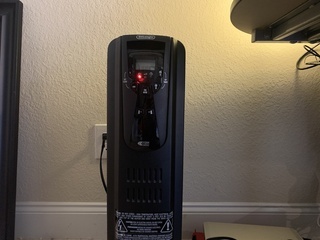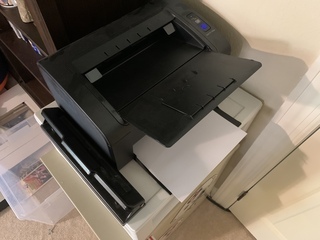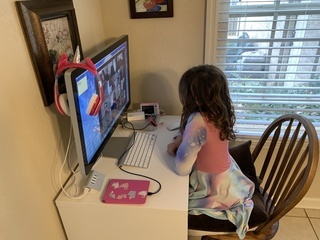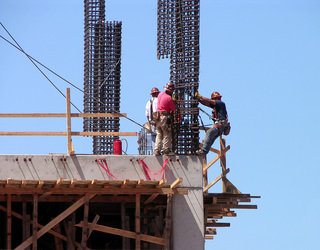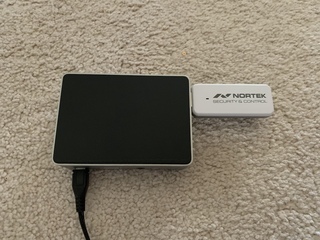petfeedd
December 2, 2020
I’ve had several people write me recently and ask about how to use petfeedd
with multiple servos. It’s actually now my most common feature request, so I
will definitely be sure that that is added in the rewrite that I am currently
working on.
In the meantime, you can run multiple instances of petfeedd using Docker, each
pointed to a different servo. I would be sure to offset each servo by a few
seconds to be sure you don’t have any voltage drop issues with the Raspberry Pi.
Read More
Parenthood
August 14, 2020
Well, here we are five months later and COVID-19 is still a thing. And like many
parents we are facing the need to continue our daughter’s education at home. Our
local school district has stated that all learning will be conducted online for
at least the first nine weeks. And even if they allow for students to return, we
will probably opt to keep her at home for awhile longer until things are more
stable.
Now, our daughter is seven and will be turning eight in a couple months. So
she’s at that age where she’s old enough to do some things independently. But,
as most of us know, the Internet is not a safe place for a seven year old and we
as parents need to exercise some level of control over the things they can
access. And while the best solution is a set of eyes, we obviously can’t be
everywhere at all times. So this is the solution I came up with.
Read More
Home Assistant
May 18, 2020
One of the big missing pieces from my conversion to Home Assistant
was Amazon Alexa integration. It wasn’t something we used a lot, but it was a
nice to have. Especially for walking out a room and saying “Alexa, turn off the
living room lights.”
I had been putting it off a bit because the setup instructions are rather
complex. But this weekend I found
myself with a couple free hours and decided to work through it. It actually
wasn’t as difficult as I expected it to be, but it is definitely not the type
of thing a beginner or someone who does not have some programming and sysadmin
background could accomplish.
But in working through it, there was one thing that was an immediate red flag
for me: the need to expose your Home Assistant installation to the Internet. It
makes sense that you would need to do this - the Amazon mothership needs to send
data to you to take an action after all. But exposing my entire home automation
system to the Internet seems like a really, really bad idea.
So in doing this, rather than expose port 443 on my router to the Internet and
open my entire home to a Shodan attack, I decided to try something a bit
different.
Read More
Randomness
April 19, 2020
Yesterday, Marc Andreessen, one of the more influential Silicon Valley investors,
dropped an essay on the Andreessen-Horowitz blog called It’s Time To
Build. I read it with a sense
of bemusement because, like most things that come out of wealthy elites, and
especially wealthy coastal elites (and especially wealthy Silicon Valley
elites), it is filled with the myopia that can only come from spending far too
much time in a bubble disconnected from what’s going on in the rest of the
world.
In short, the main thesis of his essay is that we’ve stopped building “things,”
which, in this context is housing and medical devices but can more broadly be
interpreted as a loss of civilizational inertia, because we stopped “wanting
them.”
Read More
Coronavirus
March 31, 2020
There was a great article that was recently posted by the Harvard
Business Review that I think bears some very important consideration by
everyone.
Stress is easy to identify, and we are all certainly stressed. The
predictability of our daily lives has been interrupted. Many of us have lost
jobs, faced furloughs or pay cuts. Our kids are home from school. We’re worried
about our families catching this disease, and ourselves as well. We’re all
stuck together in this purgatory of waiting for this crisis to play itself out
with no idea of what kind of world waits for us on the other side. We know that
this will end - all pandemics eventually do - but we’re going to emerge from our
shelters into a changed world.
My wife and I have spent the last couple of weekends cleaning out closets. It
kind of feels like rearranging the deck chairs on the Titanic at times, but it
also keeps my mind occupied for the most part and keeps it from going into
pretty dark places. And hey, my closet is now the cleanest it’s been since we
moved. But every so often my mind ends up going there anyways.
Such as from seeing a pile of T-shirts.
Read More
Coronavirus
March 22, 2020
If you ask people over a certain age, they can always tell you where they were
when they found out about 9/11.
I was a sophomore at Auburn, and my first class that day was at like 1pm, so I
enjoyed the great collegiate tradition of sleeping in. Usually when I wake up
the first thing I do is check my email. It’s still the first thing I do. That
morning my inbox was full with messages on the fraternity mailing list, with
things like “pray, a lot of people are dying today.” I turned on the TV just
minutes before the first tower collapsed.
Stayed glued to the TV the rest of the day. News coverage was on every channel,
even Discovery Channel. Class was cancelled. I went and filled up my car in case
I needed to drive the 250 miles back home to Tennessee.
That evening I was in the SGA office in Foy Student Union folding thousands of
little yellow ribbons for a very hastily organized memorial service on Samford
lawn a few days later. We listened to President Bush’s speech on a small boombox
in the office.
I feel like I have been living that day over and over again for the last two
weeks.
Read More
Randomness
March 20, 2020
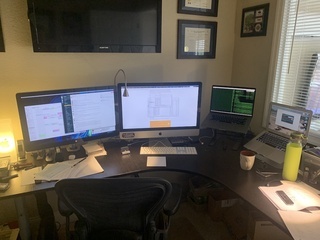
I’ve been working from home occasionally for probably close to ten years now,
and full-time for the last few months. Thanks to the COVID-19 pandemic, many
more people are now getting to enjoy (I guess?) the privilege of working from
their homes during the crisis.
If there is one thing that I hope comes out of this whole miserable period it is
the understanding that there are a lot of people out there have jobs that
really don’t need physical presence in an office building. And if they don’t
need to be in an office, maybe they don’t need to live in an expensive city
either. This could be the beginning of a whole new boom for small and mid-sized
cities with affordable costs of living. Maybe you can afford a house after all!
And maybe companies don’t need to lease out an expensive building in an
expensive city, fill it to the brim with people in open floor plans or (even
worse) hot-desking to do the work they need to do.
It’s an even bigger win for disabled and non-neurotypical people who often
struggle to work in the modern knowledge workforce despite their skills. For
people with autism, ADHD, and other related conditions, modern open offices or
cubicles are a difficult work environment whereas the home environment may offer
much more safety and control.
If this is your first time doing this, it may seem a bit odd, even naughty, to
be working without commuting to an office building. With that in mind, I’ve put
together a list of things I have observed over the years of working from home
to help you get a feel for what this is like.
Read More
Home Assistant
March 11, 2020
I have been a SmartThings user for many years. The orginal reason was that, when
we bought our current house in 2012, I wanted to turn the eave lights on at
sunset and off a few hours later. After a short attempt to use Wifi-based Wemo
switches, I settled on SmartThings and GE Z-Wave switches.
I was so happy with it that I started putting them in more places. I added
Kwikset SmartCode keypad locks and door sensors. I added more switches, like to
turn on the garage overhead lights when the doors opened. I added sensors to
monitor the temperature in the closet where I keep my server. And for many years
this setup worked great.
But over the last year, and especially since Samsung acquired SmartThings, I
have become increasingly disillusioned with the SmartThings ecosystem. This last
week, my disillusionment and frustration finally boiled over, and I migrated to
a new platform.
So why did I abandon SmartThings?
Read More
